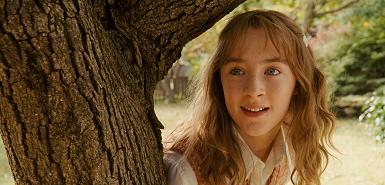|
Under the hammy direction of Peter Jackson The Lovely Bones has
lost its poetic bone structure. What was a complex, quirky novel has
been turned into a movie mishmash of Lord of the Rings and High School
Musical, with a serial killer thrown in. That might be a winning
combination for a comedy, but this film is tragic in execution and
subject. In America it played so badly to adult audiences that the
advertising campaign was reconfigured to woo teenagers.
Yet there are some magnificent performances, particularly that of
Saoirse Ronan. Fresh from her role in Atonement, the Irish actress plays
Susie Salmon, a 14-year-old schoolgirl raped and murdered in an
underground den by a next door neighbour in suburban Pennsylvania. Ronan
is a natural, and shows us Susie’s innocence peeling away layer by
layer. From the afterlife, as a very solid ghost, Susie retells her
family’s experiences before and after the crime: half post mortem, half
detective story.
Alice Sebold’s book sold more than a million copies and is
toothsome material, but in Jackson’s Tolkien-tainted hands what should
have been an intimate feminine portrait becomes an epic landscape.
Susie’s wanderings in the “in-between” (a sort of scenic departure
lounge for Heaven) are dealt with lightly in the book, but Jackson has
conveniently relocated Heaven to his native New Zealand, and the shots
of shiny lakes and mountains look like offcuts from Middle Earth.
As you know, Heaven is tricky to get just right on camera, and
Jackson acknowledged this, saying he wanted to film it as “somehow
ethereal and emotional, but it can’t be hokey”. On the contrary, if
there is an Oscar for computer-generated hokey Jackson’s so in the
running, with electric-green leaves that fly off trees and become yellow
birds, cardboard full moons, full-sized ships in bottles smashing on
rocks and cornfields romping with girls in Laura Ashley dresses.
This silliness clashes irritatingly with the bloody violence of
the murder: indeed the leaps from gruesome to fey sometimes drew
laughter from the audience. The best scenes in The Lovely Bones are not
the fantasy but the East Coast cornfields and claustrophobic domestic
life in the clapboard suburbs of the Seventies. For that retro feel, the
cinematographer Andrew Lesnie studied Andrew Wyeth paintings, and he
uses curious Kodachrome colouring from faded photos, all greenish skies
and burnt orange furniture in Susie’s family home. Plus the set
designers worked hard to source a wide selection of really bad Seventies
patterned wallpapers, tchotchkes and carefully preserved editions of
Seventeen magazine.
The ethos is psychedelic, as is the score — perhaps inevitably —
by Brian Eno. I didn’t realise the cack hand of Eno was upon the film
until afterwards, but I knew the music was wrong, somehow, when the
appearance of the knitted hat worn by the murdered Susie was clumsily
pre-signalled by jingle bells and chords of doom.
The actors battle courageously against the production. Susan
Sarandon rocks in with a cameo as a chain-smoking, whisky-drinking, foxy
grandmother with big hair. Mark Wahlberg and Rachel Weisz put in solid
performances as the father and mother suffering the fall-out after the
murder. Stanley Tucci’s portrayal of the serial killer is all the more
impressively controlling and twitchy if you’ve just seen him play the
cuddly foodie husband of Julia Child in Julie and Julia. The killer
builds doll’s houses, and makes equally intricate designs for the
hideouts where he plans to kill more doll-like girls, carefully
organising his duct tape, saws and hammers like any DIY enthusiast. The
result is stomach-churning.
It’s important that these
inexplicably popular themes — the missing girl, the serial killer, the
sadistic pervert with a home-made dungeon — are handled well on screen,
as we watch their grisly replay in newspaper stories about Madeleine
McCann and Josef Fritzl. Yet you wonder uneasily if this dwelling
on the creep and his meticulous clean-up — it’s almost “Tide: the first
choice for serial killers!” — allows the film to lose the redeeming
power of the dead girl’s point of view.
I read after the screening that Lynne Ramsay, the director of the
weird and wonderful Morvern Callar, was lined up to make this film
before the deal fell through. Shame. High on CGI, Jackson has lost any
sense of the spiritual. |



